Labour Statistics: Research Papers
Annual review of the labour market, 2018
Archived Content
Information identified as archived is provided for reference, research or recordkeeping purposes. It is not subject to the Government of Canada Web Standards and has not been altered or updated since it was archived. Please "contact us" to request a format other than those available.
Skip to text
Text begins
Introduction
This article highlights key developments in the Canadian labour market in 2018. Following strong growth in 2017, employment continued to increase in 2018, and the unemployment rate continued to fall, reaching record-low levels by October. Declines in the unemployment rate were fairly wide-spread, and certain demographic groups saw notable shifts in other labour market characteristics. The long-term trend of increasing labour force participation for people aged 55 and older was tempered by a decline among men in this age group in 2018. Employment growth was concentrated among immigrants, with important gains for male newcomers in the core working ages of 25 to 54. Employment rates were also up for core-aged women, and First Nations men living off reserve.
Provincially, British Columbia, Ontario, and Quebec led gains in employment, with growth also continuing in Alberta. Saskatchewan and Newfoundland and Labrador saw little change in employment in 2018. There were notable gains in payroll employment in manufacturing, computer-related jobs, and among public sector employees. Growth in weekly earnings was observed in sectors where employees are predominantly paid by the hour, and coincided with increases in the minimum wage in some jurisdictions.
The following analysis incorporates data from a variety of sources. Demographic and provincial analysis is primarily based on data from the Labour Force Survey (LFS), while the Survey of Employment, Payrolls and Hours (SEPH) is used to examine changes in payroll employment and earnings by industrial sector. Data from the Job Vacancy and Wage Survey (JVWS) and from Employment Insurance (EI) statistics are also included. All analysis is based on annual averages, unless otherwise noted.
Changing demographics of Canada’s labour market
The Canadian labour market is shaped by both economic and demographic factors. The following sections highlight how unemployment, labour force participation, and employment changed for different groups in 2018.
Record low unemployment rate in 2018
The unemployment rate has traditionally been an important indicator of the health of the Canadian labour market. By this measure, 2018 was a strong year.
Following a marked decrease the previous year, the annual unemployment rate in 2018 fell to an average of 5.8%, down from 6.3% in 2017, the lowest annual rate since the beginning of the current series in 1976 (Chart 1).Note The decrease in the unemployment rate was broadly based across demographic groups. In particular, the rate was down by 0.5 percentage points in each of the three major age groups (15 to 24, 25 to 54, and 55 and over) and fell by 0.7 points among men and by 0.3 points among women.
The unemployment rate decline in 2018 was primarily the result of a 7.3% (-91,000) decrease in the number of unemployed persons. Nearly 70% of this decline was among men, particularly those aged 25 to 54.
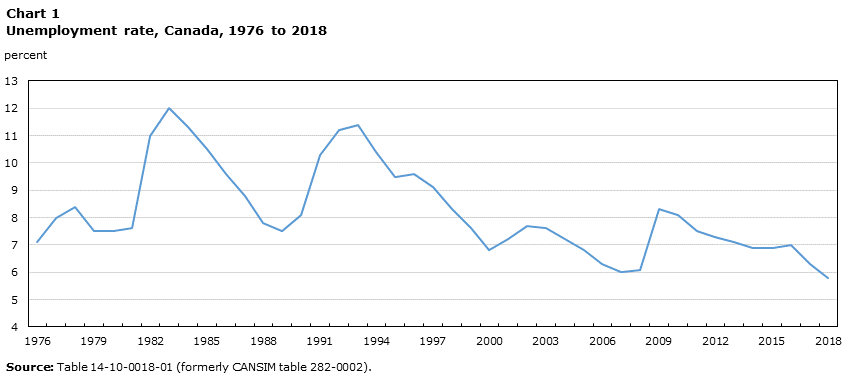
Data table for Chart 1
| Year | Unemployment rate |
|---|---|
| percent | |
| 1976 | 7.1 |
| 1977 | 8.0 |
| 1978 | 8.4 |
| 1979 | 7.5 |
| 1980 | 7.5 |
| 1981 | 7.6 |
| 1982 | 11.0 |
| 1983 | 12.0 |
| 1984 | 11.3 |
| 1985 | 10.5 |
| 1986 | 9.6 |
| 1987 | 8.8 |
| 1988 | 7.8 |
| 1989 | 7.5 |
| 1990 | 8.1 |
| 1991 | 10.3 |
| 1992 | 11.2 |
| 1993 | 11.4 |
| 1994 | 10.4 |
| 1995 | 9.5 |
| 1996 | 9.6 |
| 1997 | 9.1 |
| 1998 | 8.3 |
| 1999 | 7.6 |
| 2000 | 6.8 |
| 2001 | 7.2 |
| 2002 | 7.7 |
| 2003 | 7.6 |
| 2004 | 7.2 |
| 2005 | 6.8 |
| 2006 | 6.3 |
| 2007 | 6.0 |
| 2008 | 6.1 |
| 2009 | 8.3 |
| 2010 | 8.1 |
| 2011 | 7.5 |
| 2012 | 7.3 |
| 2013 | 7.1 |
| 2014 | 6.9 |
| 2015 | 6.9 |
| 2016 | 7.0 |
| 2017 | 6.3 |
| 2018 | 5.8 |
| Source: Table 14-10-0018-01 (formerly CANSIM table 282-0002). | |
Other labour market indicators pointed to continued strength in the labour market
Other indicators related to unemployment also pointed to positive trends in the labour market in 2018, though according to some of these measures, labour market activity had not fully returned to the state observed just prior to the 2008/2009 recession.
For example, long-term unemployment, defined here as the proportion of the unemployed who had been unemployed for 27 weeks or more, fell from 19.8% in 2017 to 17.3% in 2018 (Chart 2).Note Despite this decline, this proportion (17.3%) was still above the proportion (about 13%) observed just prior to the 2008/2009 recession. The average duration of unemploymentNote also declined to 18.3 weeks (-1.4 weeks) in 2018.
Decreases in the average duration of unemployment were observed in half of the provinces. The average duration of unemployment was little changed in New Brunswick, Nova Scotia and Manitoba, while it increased in Saskatchewan and Newfoundland and Labrador. Despite a decline of 1.5 weeks in 2018, the average duration of unemployment in Alberta (21.6 weeks) was the highest among the provinces and was about twice as high as the average duration prior to the 2008/2009 recession.
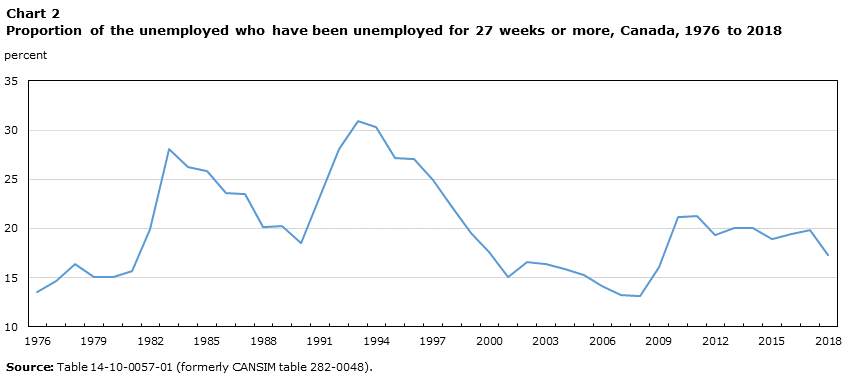
Data table for Chart 2
| Year | 27 weeks or more |
|---|---|
| percent | |
| 1976 | 13.5 |
| 1977 | 14.7 |
| 1978 | 16.4 |
| 1979 | 15.1 |
| 1980 | 15.1 |
| 1981 | 15.7 |
| 1982 | 19.9 |
| 1983 | 28.1 |
| 1984 | 26.2 |
| 1985 | 25.8 |
| 1986 | 23.6 |
| 1987 | 23.5 |
| 1988 | 20.2 |
| 1989 | 20.3 |
| 1990 | 18.5 |
| 1991 | 23.3 |
| 1992 | 28.1 |
| 1993 | 30.9 |
| 1994 | 30.3 |
| 1995 | 27.2 |
| 1996 | 27.1 |
| 1997 | 24.9 |
| 1998 | 22.2 |
| 1999 | 19.5 |
| 2000 | 17.6 |
| 2001 | 15.1 |
| 2002 | 16.6 |
| 2003 | 16.4 |
| 2004 | 15.9 |
| 2005 | 15.3 |
| 2006 | 14.2 |
| 2007 | 13.2 |
| 2008 | 13.1 |
| 2009 | 16.1 |
| 2010 | 21.2 |
| 2011 | 21.3 |
| 2012 | 19.3 |
| 2013 | 20.1 |
| 2014 | 20.0 |
| 2015 | 18.9 |
| 2016 | 19.4 |
| 2017 | 19.8 |
| 2018 | 17.3 |
| Source: Table 14-10-0057-01 (formerly CANSIM table 282-0048). | |
Similarly, the proportion of people working part-time involuntarily in 2018 fell to 21.8%, down from 24.2% in 2017,Note a share similar to that observed before the 2008/2009 recession.
Labour underutilization, which is a comprehensive measure of unemployment that includes not only the unemployed but also discouraged searchers and the under-utilized portion of involuntary part-timers,Note fell from 9.1% in 2017 to 8.3% in 2018, the lowest rate since the beginning of the series in 1997.Note
Notable participation rate developments for some groups
Besides the number of unemployed, the unemployment rate is also impacted by changes in the size of the labour force, which is the number of people who are either employed or actively searching for work. This number reflects shorter-term economic conditions as well as longer-term social and demographic trends which are affecting the size and composition of the labour force.
In 2018, the labour force increased by 0.8% (+150,000) while the total population aged 15 and older increased by 1.3%. The increase in the labour force was mainly driven by people aged 55 years and older. The slower rate of growth of the labour force compared to the population brought the participation rate down 0.4 percentage points to 65.4%.
The participation rate in Canada has been declining over the past decade, largely due to population aging and the transition of the baby-boom cohortNote into retirement. Previous analysis has concluded that, had the age structure of the population remained the same as it was in 1976, the participation rate would have been 4 percentage points higher in 2016 than was actually recorded.Note
While the labour force participation of people aged 55 and older remains markedly lower than that of younger people, their participation rate has been on the rise. This reflects a number of factors. The changing composition of older workers—such as the entry of the baby-boom cohort into this age group, higher levels of educational attainment, and changing family structures—has been shown to account for more than a third of the increase in their participation rate between 1996 and 2016.Note Other elements that may have contributed to the increase include longer life expectancy and improved health, reduced wealth or higher debt levels, and higher wages or improved employment opportunities. A special supplement to the LFS conducted in September, 2018, showed that people aged 60 and older who were still working or wanting to work were evenly split between doing so by necessity and by choice.Note
The increasing population and participation of people aged 55 and older has contributed to a rise in the contribution of this group to the overall labour force. Looking at the last forty years, persons aged 55 and older accounted for 6% of the increase in the labour force between 1977 and 1978. Between 2017 and 2018, this proportion had risen to 71% (Chart 3).

Data table for Chart 3
| Year | 15 to 24 years | 25 to 54 years | 55 years and over |
|---|---|---|---|
| thousands | |||
| 1978 | 22.3 | 71.8 | 5.9 |
| 1988 | -29.9 | 124.5 | 5.3 |
| 1998 | 14.5 | 62.8 | 22.8 |
| 2008 | 12.0 | 31.0 | 57.0 |
| 2018 | -16.9 | 45.8 | 71.1 |
| Source: Table 14-10-0018-01 (formerly CANSIM table 282-0002). | |||
Decline in participation rate of population aged 55 and older, mostly among men
In a departure from these trends, the participation rate of men aged 55 and older declined by 0.3 percentage points to 43.2% in 2018, the first notable decrease since 1995.Note Chart 4 shows how the rate of change in the number of older men participating in the labour force has been slowing in recent years, and did not keep pace with population growth for this group in 2018, resulting in little change in their participation rate in 2017, and a decline in 2018.
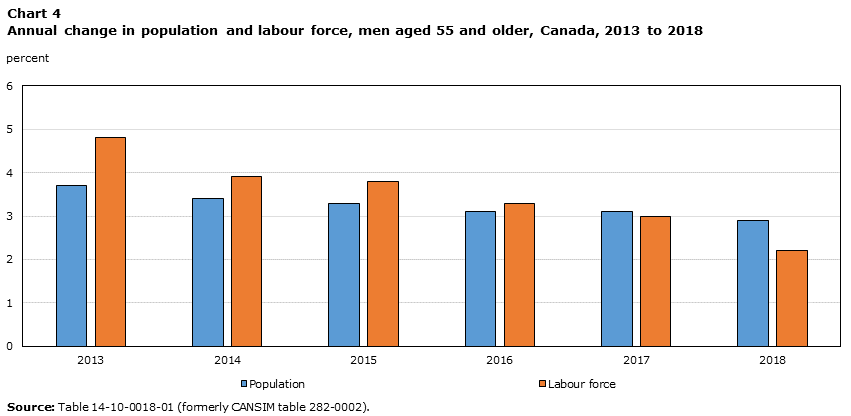
Data table for Chart 4
| Year | Population | Labour force |
|---|---|---|
| percent | ||
| 2013 | 3.7 | 4.8 |
| 2014 | 3.4 | 3.9 |
| 2015 | 3.3 | 3.8 |
| 2016 | 3.1 | 3.3 |
| 2017 | 3.1 | 3.0 |
| 2018 | 2.9 | 2.2 |
| Source: Table 14-10-0018-01 (formerly CANSIM table 282-0002). | ||
Within the 55 and older age group, those aged 55 to 64 tend to have much higher labour force participation than those aged 65 and older. In 2018, men aged 55 to 64 had a participation rate of 71.5%, in contrast to 18.1% for those aged 65 and older. Part of the decline in the participation rate of older men may be attributable to the baby-boom cohort aging into the lower participation years of 65 and older. The share of men aged 65 and older within the age 55 and older population has increased steadily from a low of 49.5% in 2010 to 53.1% in 2018.
Among older women, labour force participation was little changed in 2018 at 32.8%, following two years of increases.
More core-aged women participating in the labour market
While people aged 55 and older have been accounting for an increasing share of the labour force, the vast majority of people active in the labour market continue to fall within the core working ages of 25 to 54. The most significant change in this group over the last several decades has been the increasing labour force participation of women.
The participation rate among core-aged women continued to increase in 2018, reaching 83.2%. At the same time, the participation rate for men aged 25 to 54 decreased by 0.3 percentage points to 90.8%, the same as the rate observed in 2012. This brought the difference in participation rates between core-aged men and women to 7.6 percentage points, the smallest gap since comparable data became available in 1976.
Participation rate continues below pre-recession levels for youth
The participation rate for youth (those aged 15 to 24) decreased by 0.6 percentage points in 2018, to 63.3%. Declines in participation rates occurred for both young men and women, and among students and non-students. The labour force participation rate of youth fell during and after the 2008/2009 recession, primarily among students,Note and has not returned to pre-recession levels. The rate observed in 2018 is similar to that observed in 2012.
Distribution of employment gains in 2018
Along with unemployment and labour force participation, a third measure used to assess the state of the labour market is the employment rate. This indicator considers the number of employed persons as a percentage of the total population, which can be a more informative measure than the level of employment in isolation. Like the unemployment rate, the employment rate is impacted by both the immediate economic or business conditions and longer-terms trends in labour force participation. The value of the employment rate as a measure of shorter-term economic performance can be enhanced by focusing on the core-aged population.
While the overall employment rate was unchanged in 2018, it increased by 0.4 percentage points to 82.7% among people in the core working ages of 25 to 54.Note This followed a strong increase of 0.9 percentage points for this group in 2017. The following sections highlight some notable developments in employment and employment rates in 2018, with a focus on core-aged workers.
Employment growth almost entirely accounted for by landed immigrants
Employment among landed immigrants increased by 203,000 (+4.6%) in 2018, while it was virtually unchanged among those born in Canada.Note Apart from 2017, when strong employment gains were widespread across the labour force, net employment growth in the last five years has been almost entirely accounted for by landed immigrants (Chart 5). Recent population projections conclude that immigrants will continue to be an important element of labour force growth over the next two decades.Note

Data table for Chart 5
| Year | Landed immigrants | Born in Canada |
|---|---|---|
| thousands | ||
| 2014 | 89.2 | 22.4 |
| 2015 | 165.0 | 1.2 |
| 2016 | 233.4 | -110.8 |
| 2017 | 115.7 | 171.5 |
| 2018 | 203.0 | -2.7 |
| Source: Table 14-10-0083-01 (formerly CANSIM table 282-0102). | ||
Among the core aged population, the gap in employment rates between immigrants and the Canadian-born has been relatively stable over the last decade, with rates for Canadian-born being about 5 to 7 percentage points higher. Among immigrants, the most recent arrivals (those landed within the previous 5 years) typically have notably lower employment rates than other immigrant groups, although this varies by sex.Note
In 2018, the employment rate for immigrants aged 25 to 54 increased by 0.6 percentage points to 79.5%, as employment growth outpaced population for this group (Chart 6).Note The employment rate for core-aged people born in Canada increased by a similar amount (0.5 percentage points) to 84.5%. However, both employment and population decreased for this group. Among immigrants, employment rates increased the most for recent immigrants (landed between 5 and 10 years earlier) and very recent immigrants (landed within the previous 5 years). The employment rate was little changed for established immigrants (landed more than 10 years earlier).
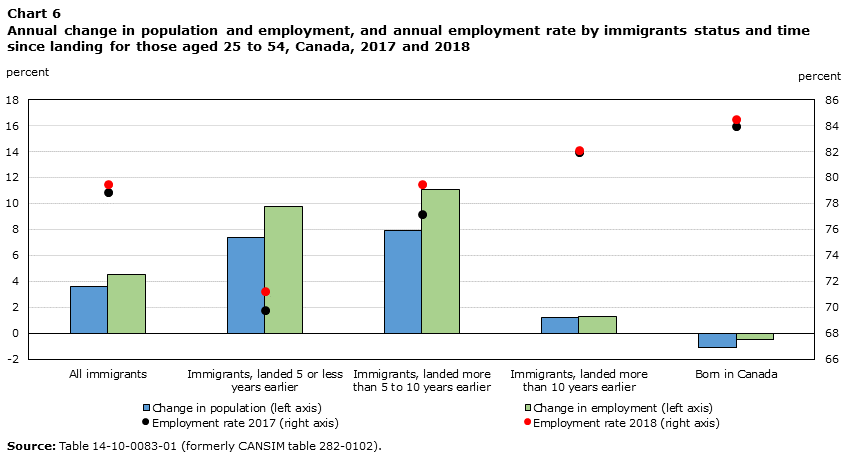
Data table for Chart 6
| Change in population | Change in employment | Employment rate 2017 | Employment rate 2018 | |
|---|---|---|---|---|
| percent | ||||
| All immigrants | 3.6 | 4.5 | 78.9 | 79.5 |
| Immigrants, landed 5 or less years earlier | 7.4 | 9.8 | 69.8 | 71.3 |
| Immigrants, landed more than 5 to 10 years earlier | 7.9 | 11.1 | 77.2 | 79.5 |
| Immigrants, landed more than 10 years earlier | 1.2 | 1.3 | 82.0 | 82.1 |
| Born in Canada | -1.1 | -0.5 | 84.0 | 84.5 |
| Source: Table 14-10-0083-01 (formerly CANSIM table 282-0102). | ||||
The increased employment rate for recent immigrants was driven by women, while the gains among very recent immigrants were led by men.Note In fact, the employment rate for very recent male immigrants aged 25 to 54 continued an upward trend that began in 2014, and reached near-parity with that of their Canadian-born counterparts in 2018 (Chart 7).Note Recent and established male immigrants in this age group have typically had employment rates similar to Canadian-born men.
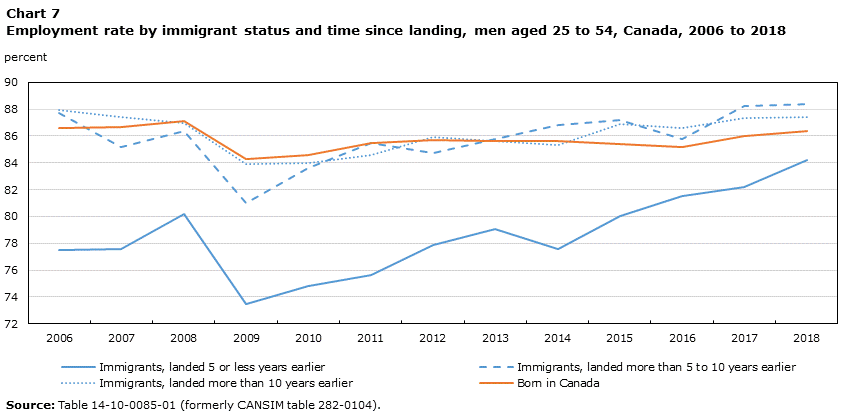
Data table for Chart 7
| Year | Immigrants, landed 5 or less years earlier | Immigrants, landed more than 5 to 10 years earlier | Immigrants, landed more than 10 years earlier | Born in Canada |
|---|---|---|---|---|
| percent | ||||
| 2006 | 77.5 | 87.7 | 87.9 | 86.6 |
| 2007 | 77.6 | 85.2 | 87.4 | 86.7 |
| 2008 | 80.2 | 86.4 | 87.0 | 87.1 |
| 2009 | 73.5 | 81.0 | 83.9 | 84.3 |
| 2010 | 74.8 | 83.6 | 84.0 | 84.6 |
| 2011 | 75.6 | 85.5 | 84.6 | 85.5 |
| 2012 | 77.9 | 84.7 | 85.9 | 85.7 |
| 2013 | 79.1 | 85.8 | 85.6 | 85.6 |
| 2014 | 77.6 | 86.8 | 85.3 | 85.6 |
| 2015 | 80.0 | 87.2 | 86.9 | 85.4 |
| 2016 | 81.5 | 85.8 | 86.6 | 85.2 |
| 2017 | 82.2 | 88.2 | 87.3 | 86.0 |
| 2018 | 84.2 | 88.4 | 87.4 | 86.4 |
| Source: Table 14-10-0085-01 (formerly CANSIM table 282-0104). | ||||
Record-high employment rates for core-aged and older women
Along with the increased labour force participation noted above, employment for core-aged women increased by 1.1% in 2018.Note This was the second-highest growth rate since 2007, following the 1.4% increase in 2017. The increase brought their employment rate to 79.1%, the highest since 1976. Unlike 2017, when widespread employment gains drove the increased employment rate for core-aged women, the improved rate in 2018 was primarily due to increased employment for this group in Alberta.
Record-high employment rates were also observed for specific groups of core-aged women, although comparable data has not been available for as long a period (Chart 8). Core-aged women who were landed immigrants posted their highest employment rate (72.7%) since that series began in 2006.Note Core-aged Aboriginal women had an employment rate of 68.5% in 2018, their highest since the series began in 2007, and the gap between these women and their non-Aboriginal counterparts (11.0 percentage points) was at its narrowest since 2007.Note
Among all women aged 55 and older, employment grew by 3.6% and their employment rate increased to 31.3%, the highest since comparable data became available in 1976.Note
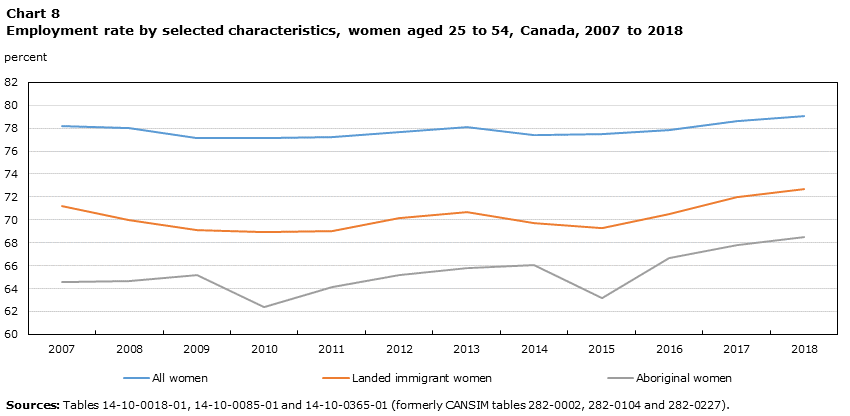
Data table for Chart 8
| Year | All women | Landed immigrant women | Aboriginal women |
|---|---|---|---|
| percent | |||
| 2007 | 78.2 | 71.2 | 64.6 |
| 2008 | 78.0 | 70.0 | 64.7 |
| 2009 | 77.1 | 69.1 | 65.2 |
| 2010 | 77.1 | 68.9 | 62.4 |
| 2011 | 77.2 | 69.0 | 64.1 |
| 2012 | 77.7 | 70.2 | 65.2 |
| 2013 | 78.1 | 70.7 | 65.8 |
| 2014 | 77.4 | 69.7 | 66.1 |
| 2015 | 77.5 | 69.3 | 63.2 |
| 2016 | 77.8 | 70.5 | 66.7 |
| 2017 | 78.6 | 72.0 | 67.8 |
| 2018 | 79.1 | 72.7 | 68.5 |
| Sources: Tables 14-10-0018-01, 14-10-0085-01 and 14-10-0365-01 (formerly CANSIM tables 282-0002, 282-0104 and 282-0227). | |||
Employment stable for youth and older men
There was virtually no change in employment levels for youths aged 15 to 24 in 2018, and their employment rate was 56.3%.
While their participation rate declined, the employment rate for men aged 55 and older was little changed at 40.8%, as employment for this group increased by 2.7% in 2018, essentially keeping pace with population growth. This was the slowest pace of employment growth for this group since 1998.
Employment gains for core-aged First Nations men
Employment grew by 2.8% among Aboriginal people in the core working ages of 25 to 54, compared with 1.0% among their non-Aboriginal counterparts.Note Their employment rate also increased by 1.0 percentage point to 71.3%, the highest level since comparable data became available in 2007.
The employment gains among Aboriginal people were driven by an increase of 7.1% among core-aged First Nations men. This pushed the employment rate for this group up by 3.6 percentage points to 70.9%, nearly returning to rates observed immediately before the 2008/2009 recession.
Canada’s provincial labour markets
The following sections review key labour market developments in 2018 from a provincial perspective.
Employment continues to grow in the three largest provinces; Alberta gains strength
Following robust gains in 2017, total employment continued to grow in 2018, albeit at a somewhat slower pace. In 2018, total employment rose by 1.3% (+241,000), down from 1.9% in 2017.Note Similar to 2017, the increase was spread across a majority of provinces, including Ontario, Quebec and British Columbia (Chart 9). Employment in Alberta rose strongly in 2018, while little growth was registered in Newfoundland and Labrador and Saskatchewan, the other two oil-producing provinces.
Despite gains in total employment, the annual employment rates in 2018 in Ontario, Quebec and British Columbia were little changed compared with 2017, as population increased at a similar rate. Stronger employment gains in Alberta relative to population growth brought the employment rate up 0.5 percentage points to 67.2% in this province, while the employment rates in Newfoundland and Labrador and Saskatchewan were little changed.
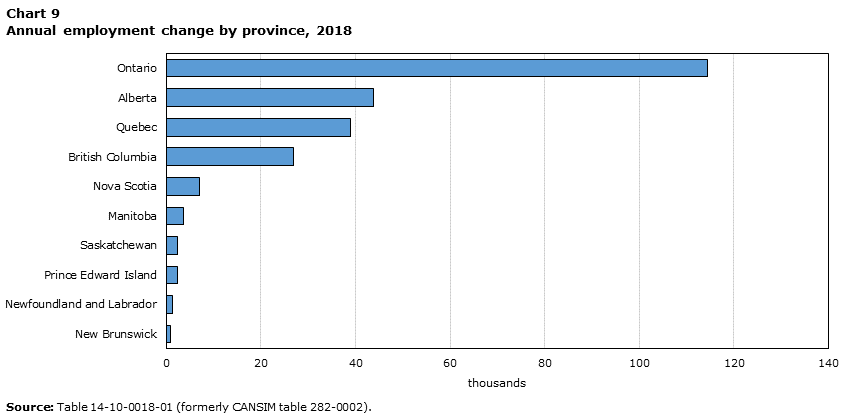
Data table for Chart 9
| Annual change | |
|---|---|
| thousands | |
| Ontario | 114.4 |
| Alberta | 43.8 |
| Quebec | 38.9 |
| British Columbia | 26.8 |
| Nova Scotia | 6.9 |
| Manitoba | 3.6 |
| Saskatchewan | 2.4 |
| Prince Edward Island | 2.3 |
| Newfoundland and Labrador | 1.2 |
| New Brunswick | 0.9 |
| Source: Table 14-10-0018-01 (formerly CANSIM table 282-0002). | |
Ontario drives gains in employment
Among Ontario, Quebec and British Columbia, Ontario registered the largest employment gains (+114,000 or +1.6%) in 2018, followed by Quebec (+39,000 or +0.9%) and British Columbia (+27,000 or +1.1%). For a second year in a row, the unemployment rates of all three provinces were below the national average (5.8%), pointing to continued strength in these provinces. In Quebec in particular, the unemployment rate declined to 5.5%, the second lowest rate among the provinces and the lowest on record for this province. In 2018, British Columbia had the lowest unemployment rate at 4.7%.
In general, total employment gains were concentrated in certain areas of these provinces. For example, the economic regions of Montréal (+23,000) and Laval (+17,000) accounted for the entire net increase in the province of Quebec, while gains in Toronto (+79,000) and Ottawa (+14,000) together represented over 80% of the increase in Ontario.Note
The increase in payroll employment in Ontario, Quebec and British Columbia was observed across a majority of sectors, with above-average growth recorded in construction, educational services, and public administration. Several sectors, however, did not perform as strongly. In Ontario, increases in payroll employment slowed noticeably in accommodation and food services, with growth decelerating from an elevated 4.2% in 2017 to 1.4% in 2018, while retail trade (+0.8%) also registered below-average growth.Note
As the number of unemployed in these provinces declined, their number of EI beneficiaries fell as well. Compared with 2017, the average number of EI recipients in 2018 fell by 18.1%, 13.7%, and 10.9% in British Columbia, Quebec and Ontario, respectively and decreases were widespread within these provinces.Note Notable declines were registered in the census metropolitan areas of Kelowna, British Columbia (-22.7%), Saguenay, Quebec (-17.0%), and Greater Sudbury, Ontario (-20.0%).
In 2018, these three provinces had some of the highest job vacancy rates among the 10 provinces, with British Columbia having the highest at 4.5%.Note Within British Columbia, Lower Mainland–Southwest, which includes Vancouver, had the highest rate (4.8%). The job vacancy rate refers to the number of job vacancies as a percentage of occupied and vacant jobs.
Notable employment gains in Alberta
In Alberta, total employment in 2018 rose by 44,000 (+1.9%), almost twice the increase recorded in 2017 in this province.Note Over 40% of the growth was driven by self-employment (+19,000).Note In 2018, the unemployment rate in Alberta decreased for a second year in a row, reaching an annual average of 6.6%, down from a recent high of 8.1% in 2016.Note
Labour market conditions in Alberta, Newfoundland and Labrador and Saskatchewan have been affected by declines in global oil prices since the fall of 2014. From the beginning of 2016 to the fall of 2018, oil prices partially recovered, with prices for West Texas Intermediate averaging about US$50 a barrel in December 2018 (Chart 10). In November 2018, however, the Western Canadian Select, the price obtained by many Alberta oil producers, dropped abruptly, with the decline being partly attributable to a backlog of oil in Alberta.Note
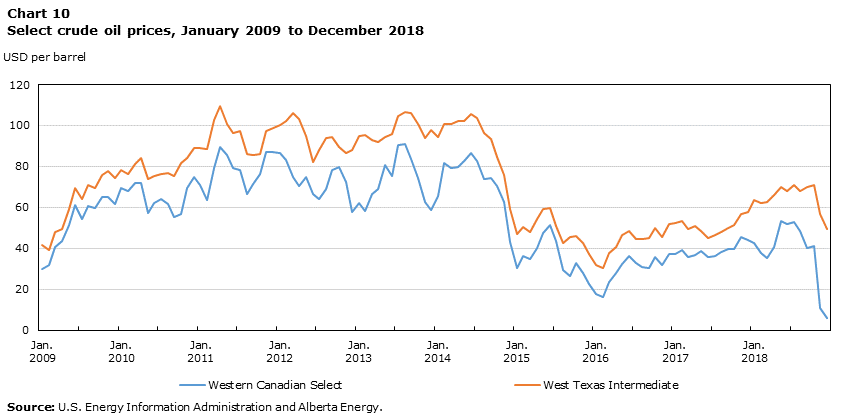
Data table for Chart 10
| Western Canadian Select | West Texas Intermediate | ||
|---|---|---|---|
| USD per barrel | |||
| 2009 | Jan. | 29.97 | 41.71 |
| Feb. | 31.71 | 39.09 | |
| Mar. | 40.76 | 47.94 | |
| Apr. | 43.76 | 49.65 | |
| May | 51.64 | 59.03 | |
| June | 61.18 | 69.64 | |
| July | 54.45 | 64.15 | |
| Aug. | 60.57 | 71.05 | |
| Sept. | 59.52 | 69.41 | |
| Oct. | 65.29 | 75.72 | |
| Nov. | 65.04 | 77.99 | |
| Dec. | 61.89 | 74.47 | |
| 2010 | Jan. | 69.28 | 78.33 |
| Feb. | 67.91 | 76.39 | |
| Mar. | 71.82 | 81.20 | |
| Apr. | 72.02 | 84.29 | |
| May | 57.49 | 73.74 | |
| June | 62.33 | 75.34 | |
| July | 64.28 | 76.32 | |
| Aug. | 61.93 | 76.60 | |
| Sept. | 55.44 | 75.24 | |
| Oct. | 56.72 | 81.89 | |
| Nov. | 69.56 | 84.25 | |
| Dec. | 74.89 | 89.15 | |
| 2011 | Jan. | 71.18 | 89.17 |
| Feb. | 63.42 | 88.58 | |
| Mar. | 79.13 | 102.86 | |
| Apr. | 89.69 | 109.53 | |
| May | 85.66 | 100.90 | |
| June | 79.42 | 96.26 | |
| July | 78.31 | 97.30 | |
| Aug. | 66.51 | 86.33 | |
| Sept. | 71.60 | 85.52 | |
| Oct. | 76.54 | 86.32 | |
| Nov. | 87.32 | 97.16 | |
| Dec. | 86.86 | 98.56 | |
| 2012 | Jan. | 86.47 | 100.27 |
| Feb. | 83.04 | 102.20 | |
| Mar. | 75.01 | 106.16 | |
| Apr. | 70.40 | 103.32 | |
| May | 75.10 | 94.66 | |
| June | 66.37 | 82.30 | |
| July | 64.28 | 87.90 | |
| Aug. | 69.03 | 94.13 | |
| Sept. | 78.17 | 94.51 | |
| Oct. | 79.88 | 89.49 | |
| Nov. | 72.47 | 86.53 | |
| Dec. | 57.87 | 87.86 | |
| 2013 | Jan. | 62.11 | 94.76 |
| Feb. | 58.40 | 95.31 | |
| Mar. | 66.72 | 92.94 | |
| Apr. | 68.87 | 92.02 | |
| May | 80.93 | 94.51 | |
| June | 75.39 | 95.77 | |
| July | 90.50 | 104.67 | |
| Aug. | 90.97 | 106.57 | |
| Sept. | 83.57 | 106.29 | |
| Oct. | 74.21 | 100.54 | |
| Nov. | 62.62 | 93.86 | |
| Dec. | 58.95 | 97.63 | |
| 2014 | Jan. | 65.69 | 94.62 |
| Feb. | 81.54 | 100.82 | |
| Mar. | 79.42 | 100.80 | |
| Apr. | 79.56 | 102.07 | |
| May | 82.72 | 102.18 | |
| June | 86.56 | 105.79 | |
| July | 82.73 | 103.59 | |
| Aug. | 73.89 | 96.54 | |
| Sept. | 74.35 | 93.21 | |
| Oct. | 70.60 | 84.40 | |
| Nov. | 62.87 | 75.79 | |
| Dec. | 43.24 | 59.29 | |
| 2015 | Jan. | 30.43 | 47.22 |
| Feb. | 36.52 | 50.58 | |
| Mar. | 34.76 | 47.82 | |
| Apr. | 40.26 | 54.45 | |
| May | 47.50 | 59.27 | |
| June | 51.29 | 59.82 | |
| July | 43.49 | 50.90 | |
| Aug. | 29.48 | 42.87 | |
| Sept. | 26.50 | 45.48 | |
| Oct. | 32.78 | 46.22 | |
| Nov. | 27.78 | 42.44 | |
| Dec. | 22.51 | 37.19 | |
| 2016 | Jan. | 17.88 | 31.68 |
| Feb. | 16.30 | 30.32 | |
| Mar. | 23.46 | 37.55 | |
| Apr. | 27.88 | 40.75 | |
| May | 32.52 | 46.71 | |
| June | 36.47 | 48.76 | |
| July | 32.80 | 44.65 | |
| Aug. | 30.90 | 44.72 | |
| Sept. | 30.62 | 45.18 | |
| Oct. | 35.83 | 49.78 | |
| Nov. | 31.89 | 45.66 | |
| Dec. | 37.18 | 51.97 | |
| 2017 | Jan. | 37.19 | 52.50 |
| Feb. | 39.14 | 53.47 | |
| Mar. | 35.68 | 49.33 | |
| Apr. | 36.84 | 51.06 | |
| May | 38.84 | 48.48 | |
| June | 35.80 | 45.18 | |
| July | 36.37 | 46.63 | |
| Aug. | 38.50 | 48.04 | |
| Sept. | 39.93 | 49.82 | |
| Oct. | 39.87 | 51.58 | |
| Nov. | 45.52 | 56.64 | |
| Dec. | 44.02 | 57.88 | |
| 2018 | Jan. | 42.53 | 63.70 |
| Feb. | 37.72 | 62.23 | |
| Mar. | 35.53 | 62.73 | |
| Apr. | 40.47 | 66.25 | |
| May | 53.25 | 69.98 | |
| June | 52.10 | 67.87 | |
| July | 52.83 | 70.98 | |
| Aug. | 48.55 | 68.06 | |
| Sept. | 40.37 | 70.23 | |
| Oct. | 41.15 | 70.75 | |
| Nov. | 11.03 | 56.96 | |
| Dec. | 5.97 | 49.52 | |
| Source: U.S. Energy Information Administration and Alberta Energy. | |||
Payroll employment in Alberta grew in many sectors, notably health care and social assistance, manufacturing, and educational services.Note However, these gains were tempered by declines in construction and retail trade. The number of payroll jobs in mining, quarrying, and oil and gas trended down over the course of the year, decreasing by 3.6% between December 2017 and December 2018.
In 2018, the number of EI recipients declined by 25.7% in Alberta, and the declines were broadly based within the province.Note
The job vacancy rate in this province went from an average of 2.5% in 2017 to 2.8% in 2018.Note Higher job vacancy rates tend to be associated with stronger economic activity.
Little change in employment in Newfoundland and Labrador and Saskatchewan
In 2018, employment in Newfoundland and Labrador was little changed, following little to negative annual growth in employment since 2014.Note The unemployment rate in this province fell to 13.8% from 14.8% in 2017, partly reflecting a marked decline in the number of unemployed. The number of EI beneficiaries in this province (-7.3%) was also down over the same period.Note
Among the sectors pulling down payroll employment growth in Newfoundland and Labrador were construction and retail trade, as well as accommodation and food services.Note Declines in construction were particularly strong, with payroll employment decreasing by 11.9% between 2017 and 2018. These employment losses coincide with the completion of major construction projects in the province.
At 1.9%, Newfoundland and Labrador had the lowest job vacancy rate in 2018.Note
The labour market situation in Saskatchewan also showed few improvements in 2018. Compared with 2017, employment in this province was little changed, while the unemployment rate, averaging 6.1% in 2018, was virtually unchanged compared with the previous year.Note
In 2018, notable gains in payroll employment in public administration and health care and social assistance were offset by declines in construction, finance and insurance, as well as administrative and support services.Note
The job vacancy rate in Saskatchewan averaged 2.2% in 2018,Note the lowest rate after Newfoundland and Labrador, while the average number of EI beneficiaries in 2018 decreased by 10.6% compared with the previous year.Note
Labour market outcomes by sector
The following sections highlight notable developments in payroll employment, job vacancies, and weekly earnings across the 10 major industrial sectors.
Employment in goods-producing sectors outpaces services-producing sectors
Growth in payroll employment in the services-producing sectors generally outpaces that of goods-producing sectors. However, in 2018, the rate of employment growth in goods-producing sectors (+2.6%) outpaced that of services-producing sectors (+2.1%), primarily due to employment growth in manufacturing (Chart 11).Note The number of payroll employees in the goods-producing (+75,200) and services-producing sectors (+273,000) both increased by more in 2018 compared with 2017. The growth in payroll employees in the goods-producing sectors slowed slightly in the second half of the year, while the growth in services-producing sectors slightly accelerated.
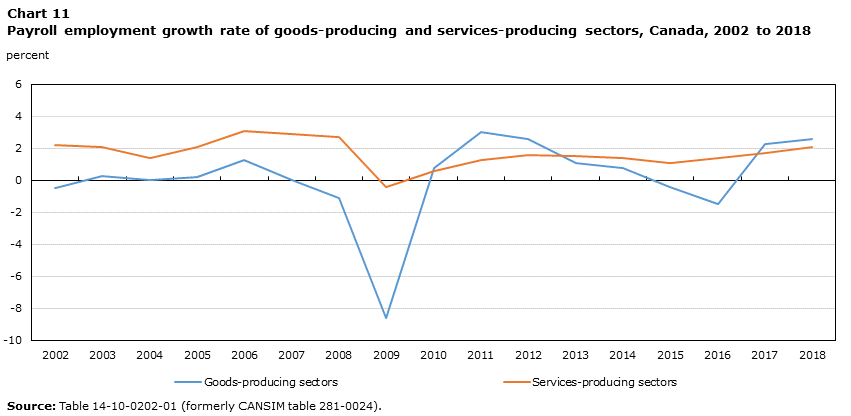
Data table for Chart 11
| Goods-producing sectors | Services-producing sectors | |
|---|---|---|
| percent | ||
| 2002 | -0.5 | 2.2 |
| 2003 | 0.3 | 2.1 |
| 2004 | 0.0 | 1.4 |
| 2005 | 0.2 | 2.1 |
| 2006 | 1.3 | 3.1 |
| 2007 | 0.0 | 2.9 |
| 2008 | -1.1 | 2.7 |
| 2009 | -8.6 | -0.4 |
| 2010 | 0.8 | 0.6 |
| 2011 | 3.0 | 1.3 |
| 2012 | 2.6 | 1.6 |
| 2013 | 1.1 | 1.5 |
| 2014 | 0.8 | 1.4 |
| 2015 | -0.4 | 1.1 |
| 2016 | -1.5 | 1.4 |
| 2017 | 2.3 | 1.7 |
| 2018 | 2.6 | 2.1 |
| Source: Table 14-10-0202-01 (formerly CANSIM table 281-0024). | ||
As shown in Chart 12, health care and social assistance (+54,400 or +2.8%) was the largest contributor to the overall employment growth in 2018, followed by manufacturing (+43,100 or +2.9%); professional, scientific and technical services (+39,900 or +4.5%); and educational services (+37,800 or +3.0%).
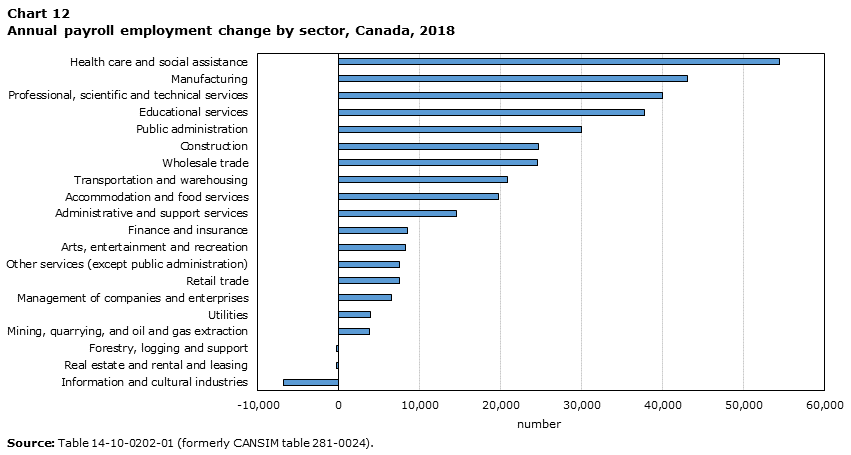
Data table for Chart 12
| Annual change | |
|---|---|
| number | |
| Health care and social assistance | 54,432 |
| Manufacturing | 43,081 |
| Professional, scientific and technical services | 39,938 |
| Educational services | 37,813 |
| Public administration | 29,944 |
| Construction | 24,659 |
| Wholesale trade | 24,554 |
| Transportation and warehousing | 20,860 |
| Accommodation and food services | 19,698 |
| Administrative and support services | 14,570 |
| Finance and insurance | 8,477 |
| Arts, entertainment and recreation | 8,212 |
| Other services (except public administration) | 7,545 |
| Retail trade | 7,537 |
| Management of companies and enterprises | 6,501 |
| Utilities | 3,909 |
| Mining, quarrying, and oil and gas extraction | 3,819 |
| Forestry, logging and support | -257 |
| Real estate and rental and leasing | -258 |
| Information and cultural industries | -6,822 |
| Source: Table 14-10-0202-01 (formerly CANSIM table 281-0024). | |
Largest manufacturing employment growth since 2000
In 2018, payroll employment in manufacturing grew for the second consecutive year (+43,100 or +2.9%). From 2010 to 2016, employment in manufacturing was virtually unchanged, following a downward trend that began in 2001 (Chart 13). Although hourly employees comprise more than two-thirds of this sector, all of the growth in 2018 was among salaried employees. The job vacancy rate in this sector was also up from 2017.Note

Data table for Chart 13
| Year | Manufacturing |
|---|---|
| number | |
| 2001 | 1,977,618 |
| 2002 | 1,930,646 |
| 2003 | 1,911,352 |
| 2004 | 1,871,921 |
| 2005 | 1,840,930 |
| 2006 | 1,822,123 |
| 2007 | 1,764,574 |
| 2008 | 1,680,733 |
| 2009 | 1,493,338 |
| 2010 | 1,477,435 |
| 2011 | 1,499,265 |
| 2012 | 1,509,853 |
| 2013 | 1,502,614 |
| 2014 | 1,492,981 |
| 2015 | 1,498,881 |
| 2016 | 1,482,131 |
| 2017 | 1,509,633 |
| 2018 | 1,552,714 |
| Source: Table 14-10-0202-01 (formerly CANSIM table 281-0024). | |
The growth in the number of employees at the subsector level was led by food, transportation equipment and machinery manufacturing.Note At the provincial level, employment growth in the sector was driven by Ontario and Quebec. In addition, relatively fast employment growth was observed in Manitoba. Compared with 2017, weekly earnings in this sector were little changed at $1,096.Note
Tech jobs continue to rise at a swift pace
Professional, scientific and technical services continued its accelerated employment growth from 2017 in to 2018. The number of employees in this sector rose by 4.5% (+39,900), the fastest rate among the 10 largest industrial sectors. Concurrently, the job vacancy rate in this sector increased between 2017 and 2018.Note
Half of the annual employment growth was from the high-paying computer systems design and related services industry, despite it comprising roughly one-quarter of employment in the sector.Note This industry was also the fastest growing within the sector, followed by scientific research and development services and architectural, engineering and related services.
Provincially, over half of the employment growth in professional, scientific and technical services came from Ontario. At the same time, New Brunswick and Quebec had high employment growth rates.
In 2018, average weekly earnings in the sector were up 2.9% to $1,386.Note Strong employment growth in the aforementioned high-paying computer systems design and related services industry contributed the most to this growth.
Health care and education jobs steadily rise
For the fifth consecutive year, the number of payroll employees increased the most in the health care and social assistance sector, up 54,400 (+2.8%) in 2018.Note All of the increase was among employees paid by the hour, which comprise 85% of the employees in this sector, the second highest proportion among all sectors. Compared with 2017, health care and social assistance had the largest increase in the number of job vacancies.Note
Payroll employment in this sector was primarily driven by ambulatory health care services.Note Growth in this subsector accounted for nearly half of the overall employment growth within the sector, while its share of the overall employment in the sector was roughly one-quarter. Employment was also up in the social assistance and nursing and residential care facilities subsectors. From 2008 to 2018, payroll employees working in health care and social assistance grew by 28%, highest among all sectors, while the industrial aggregate was up over 12%. This employment growth coincides with an aging population, as the number of people aged 65 and older has risen by over 44% since 2008, compared with 7% for the population aged 15 to 64 years old.
Average weekly earnings in health care and social assistance rose 2.1% in 2018, to $907,Note driven by ambulatory health care services. Weekly earnings in this sector vary from the lower-earning nursing and residential care facilities subsector ($705) to the higher-earning hospitals subsector ($1,113). With this disparity, average weekly earnings in the sector were lower than the national average.
Employment in educational services rose by 37,800 (+3.0%) in 2018.Note This was the largest employment growth observed in this sector since the time series began in 2001. This was the fourth consecutive year that employment growth in this sector outpaced the national average. At the same time, job vacancies were up.Note
In 2018, the number of employees were up in most industries in this sector, led by elementary and secondary schools.Note At the same time, employment in technical and trade schools increased by 3,300 or 38.4%. Provincially, Ontario, Quebec and British Columbia contributed the most to the employment growth in educational services.
Average weekly earnings in this sector were little changed at $1,052.Note
Public sector employees increase at the fastest rate for second consecutive year
The number of employees working in the public sectorNote grew by 77,000 (+2.1%) in 2018.Note This coincided with the large employment growth observed in the health care and social assistance and educational services sectors, which were two of the three sectors with the highest proportion of employees working in the public sector (54% and 91% respectively).
In the private sector, the number of employees increased by 110,000 (+0.9%). This was the third increase of less than 1.0% in four years. Following the 2008/2009 recession, the number of private sector employees grew annually by more than 1.0% from 2010 to 2014, with a peak of 2.1% in 2011. Since this period, only the relatively strong increase (+1.8%) in the number of private employees recorded in 2017 has surpassed 1.0%.
In 2018, the number of self-employed workers was up by 54,000 (+1.9%). This was the highest growth rate observed since 2013 and was driven by those who were incorporated with paid help.
Earnings up most in sectors predominantly paid by the hour
In 2018, average weekly earnings of non-farm payroll employees rose by 2.6% to $1,001.Note Earnings growth in 2018 outpaced that of 2017, when average weekly earnings were up 2.0% to $976. The increase in 2018 was the fastest annual growth rate since 2014 and was the first time annual average weekly earnings eclipsed $1,000. The pace of earnings growth slowed in the second half of 2018 compared with the first half of the year. As a comparison, the average annual increase in the Consumer Price Index was 2.3% in 2018.Note
Among the 10 largest industrial sectors, average weekly earnings grew at the fastest pace in retail trade and in accommodation and food services (Chart 14). These two sectors were among the three highest in terms of their proportion of employees being paid by the hour, with nearly 9 out of 10 (88.4%) employees in accommodation and food services, and almost 8 out of 10 (79.2%) in retail trade paid by the hour.Note
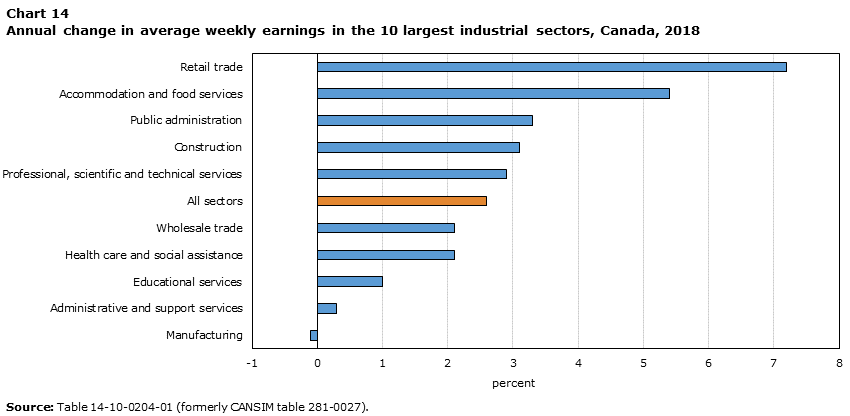
Data table for Chart 14
| Annual change | |
|---|---|
| percent | |
| Retail trade | 7.2 |
| Accommodation and food services | 5.4 |
| Public administration | 3.3 |
| Construction | 3.1 |
| Professional, scientific and technical services | 2.9 |
| All sectors | 2.6 |
| Wholesale trade | 2.1 |
| Health care and social assistance | 2.1 |
| Educational services | 1.0 |
| Administrative and support services | 0.3 |
| Manufacturing | -0.1 |
| Source: Table 14-10-0204-01 (formerly CANSIM table 281-0027). | |
In 2018, weekly earnings in retail trade increased by 7.2% to $605.Note Earnings growth was spread across most subsectors, led by general merchandise stores. Earnings in the sector were up in several provinces, driven by Ontario, Quebec and Alberta. The average offered hourly wage for the vacant positions in this sector grew by 9.3% compared with 2017, likely reflecting notable minimum wage increases in Ontario and Alberta.Note
Compared with 2017, earnings in accommodation and food services rose by 5.4% to $404,Note mostly due to gains in full-service restaurants and the limited-service eating places industry. Ontario had the largest earnings increase in this sector. The minimum wage in Ontario increased from $11.60 to $14.00 on January 1, 2018. The job vacancy rate increased and remained one of the highest rates among all sectors, while the average offered hourly wage for vacant positions in this sector rose by 8.8% compared with 2017, coinciding with the minimum wage increases.Note
In 2018, the number of individuals earning the minimum wage across Canada increased by more than 60% (+620,000) compared with 2017. Nearly 80% of the rise was recorded in Ontario.Note At the same time, more than half of the increase at the national level came from the retail trade and accommodation and food services sectors, while these sectors only accounted for 18% of total employees.Note These two sectors had the highest proportion of employed youth among all sectors. In accommodation and food services, 4 out of 10 (40.5%) of those employed were between the ages of 15 and 24 in 2018, while in retail trade youth accounted for more than one out of four (27.4%). In comparison, across all industries, 13.1% of employees were aged 15 to 24 in 2018. Average hourly wages increased by 7.2% among youth in 2018, compared with an overall increase of 2.9% among all employees.Note
Among the 10 largest industrial sectors, weekly earnings outpaced the growth of the industrial aggregate in three additional sectors: public administration (+3.3%), construction (+3.1%), and professional, scientific and technical services (+2.9%).Note Earnings were also up in health care and social assistance (+2.1%). Over the course of the year, earnings were little changed in wholesale trade, educational services, administrative and support services, as well as manufacturing.
Conclusion
This article examines several important developments in the Canadian labour market over the course of 2018. The downward trend of the unemployment rate in 2017 continued in 2018, reaching historically-low levels by October. Employment growth was concentrated among immigrants, and there were notable employment rate gains for male newcomers, core-aged women of all demographic groups, and First Nations men living off reserve. At the same time, for the first time since 1995, the labour force participation of men aged 55 and older declined, moderating the long-standing trend of increasing labour force participation for people aged 55 and older.
Employment gains at the provincial level were strongest in British Columbia, Ontario and Quebec. Employment in Alberta also continued to rise in 2018, while there was little change in the other two oil-producing provinces of Saskatchewan and Newfoundland and Labrador.
Growth in payroll employment in the goods-producing sectors outpaced the growth of services-producing sectors, led by notable gains in manufacturing. For the fifth consecutive year, payroll employment was up the most in health care and social assistance, while professional, scientific and technical services recorded the fastest employment growth among the 10 largest industrial sectors. Earnings grew the most in retail trade and in accommodation and food services, two sectors with a high proportion of employees with hourly earnings close to the minimum wage. These gains coincided with notable minimum wage increases in 2018, namely in Ontario.
- Date modified:
